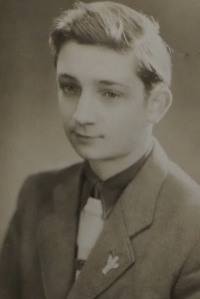The Gestapo took the uncle’s father and wife hostage

Download image
Karel Bubílek was born on July 18, 1932 in Holešov in the family of Florián and Marie Bubílková, natives of Bystřice. Charles’ father, a trained shoemaker, worked as the head of Baťa’s stores. They lived briefly in Bystřice pod Hostýnem, but Karel spent most of his childhood with his sisters in Kyjov in Slovakia. During the Heydrichiad period, his father (together with his sister-in-law Františka) was arrested after the escape of his brother Vojtěch Bubílek. His father’s brother made it all the way to England, where he became an RAF navigator. My father and sister-in-law spent a year in an internment camp in Svatobořice near Kyjov. After graduating from the Municipal School, Karel joined the forestry school in Hranice na Moravě. However, in the period after the February communist coup in 1948, he was expelled from school for his father was employed with Tomas Bata. He worked for two years as a forest intern in Blansko and in the Jizera Mountains. In 1950, already as a “workers’ cadre”, he passed the entrance exams to the Brno Academy of Arts, Architecture and Design and, under the guidance of professors Karel Langer and Zdeněk Juna, graduated after four years. In the meantime, until the start of the war, he participated in the decoration of the boarding school of the horticultural school in Lednice. He served in the military service in Slovakia in Dolný Kubín, Libava and Olomouc. After returning to civilian life, he worked briefly in the Promotional Company in what was then Gottwald. From 1961 until his retirement, he worked as a corporate graphic designer and artist in the TON company in Bystřice pod Hostýnem. He participated in countless designs and realizations of exhibitions and presentations at foreign trade fairs, where TON presented its award-winning furniture. He also cooperated similarly with the foreign trade company Ligna Praha. In the last twenty years, he has focused mainly on freelance work. He paints with watercolour, tempera and oil. He remained faithful to graphic techniques and mostly captures the natural scenery of the Hostýn region or natural still lives. Until recently, he was also an active member of the hunting association and for many years worked as a member of folklore ensembles. He lives and works in Chvalčov.






